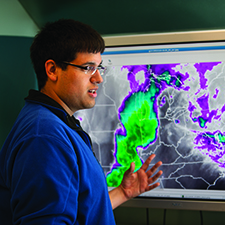Atmospheric and Climate Sciences

Extreme
Weather

EAPS faculty and students use observations and numerical modeling to better understand the physics, predictability and impacts of extreme weather systems, including thunderstorms, tornadoes, and tropical cyclones, and their variability within the climate system.
Climate
Dynamics

The fundamental physics and processes of the regional and large-scale climate system and its variability (such as monsoons, El Niño, and the jet stream), and intraseasonal variability are topics of research by our faculty and students.
Surface-ATMS Interactions

Select EAPS faculty and students study the exchange of energy and matter between the atmosphere and the Earth’s surface, including sea, land, and vegetation.

Atmospheric Science News
Is Indiana seeing more tornadoes than in the past? The answer is complicated and nuanced
04-04-2025
As Hoosiers clean up from severe storms Wednesday that battered central Indiana, scientists studying the climate say the state is likely to see an increase in the number of tornado outbreaks in the future. That prediction is based on research by the Midwestern Regional Climate Center based at Purdue University and the National Weather Service.
10 Purdue faculty chosen as fellows of the American Association for the Advancement of Science
03-27-2025
WEST LAFAYETTE, Ind. — Purdue University is recognizing faculty members who have been elected as fellows of the American Association for the Advancement of Science (AAAS), one of the most distinct honors within the scientific community. Matthew Huber, EAPS professor, is being honored for pioneering research on past and future climate dynamics, significantly advancing understanding of human-induced climate impacts and sustainability.
Severe Weather Warnings Persist After a Deadly Weekend of Tornadoes, Dust Storms and Fires
03-18-2025
Inside Climate News — Severe weather and fire warnings continue after a deadly storm system this weekend unleashed more than 50 tornadoes across the South and Midwest and spawned fierce winds, sparking dust storms, wildfires and destruction. Melissa Widhalm, associate director of the Midwestern Regional Climate Center at Purdue University, emphasized the need for increased investment in storm preparedness and emergency response nationwide.
Tornadoes, climate change and why Dixie is the new Tornado Alley
03-17-2025
SFGATE — Several deadly tornado outbreaks, some with dozens of destructive storms, have swept across the South in recent years. We asked tornado scientist Ernest Agee to explain what causes tornadoes and how the center of U.S. tornado activity has shifted eastward from the traditional Tornado Alley in recent years.
Evidence of ancient frozen ocean found on dwarf planet Ceres
02-17-2025
StudyFinds — EAPS researchers discovered that Ceres has a crust containing about 90% ice near its surface, three times more than previously thought, by showing that impurities mixed with ice can prevent it from flowing and deforming over time.